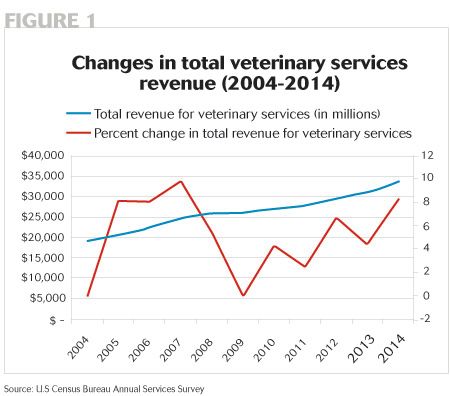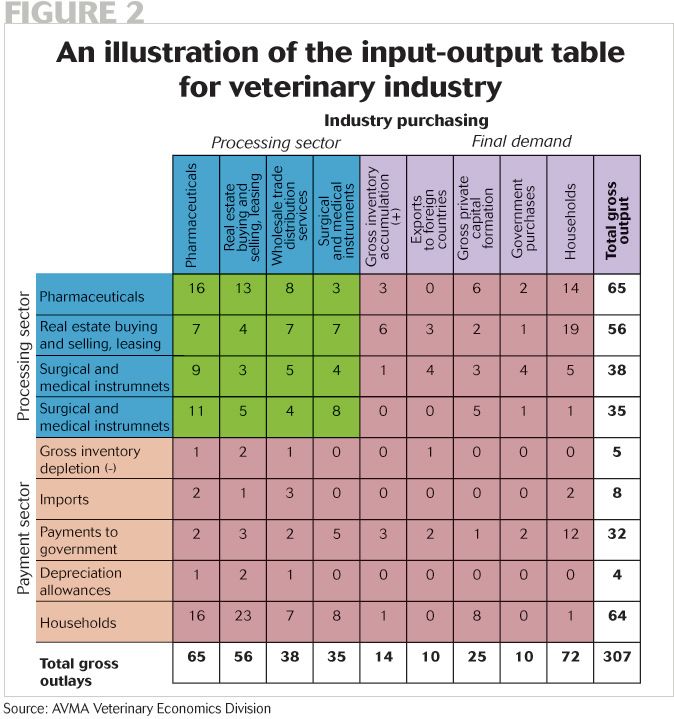Veterinary practice and the U.S. economy: Whats the impact?
The total value of economic activity generated from veterinary services in 2014? A cool $63.1 billion.
The market for veterinary services has consistently increased in size over the past decade, according to the U.S. Census Bureau, reaching approximately $33 billion in total output in 2014 (see Figure 1). This expansion might be attributable to multiple factors, including:
an increase in the number of pets and other domestic animals
regulations enacted by state and federal governments to enhance animal welfare, prevent animal abuse and ensure that all animals receive the care they deserve
the evolution in the value placed on pets by their owners.

Most important for the veterinary profession, a consumer's willingness to pay for services is at least partially dependent on household income, so a projected improvement in the conditions of the U.S. economy-and the resulting increase in household incomes-is expected to further increase the demand for veterinary services.
The willingness of pet owners to spend for veterinary services is just one of the veterinary profession's contributions to the economy as a whole. Money spent at veterinary hospitals constitutes the direct impact of veterinary services on the economy. But to provide these services, veterinarians require education and training, supplies, equipment, pharmaceuticals, facilities and staff. These “inputs” to veterinary services are produced by other businesses, and the activity generated by these businesses to produce the inputs are known as “indirect” impacts on the general economy.
Finally, all of the people employed in direct and indirect businesses spend money earned from these businesses. These expenditures for goods and services require additional labor. The sum of all of the goods and services purchased as a result of the expenditures of veterinary hospital employees, as well as employees of businesses supplying inputs to veterinary hospitals, produce what's called an “induced” impact on the economy.
The sum of the direct (veterinary hospital revenue), indirect (expenditures in related businesses) and induced (household expenditures from employees) impacts make up the total economy-wide impact of veterinary practices. Determining this economy-wide impact requires an economic impact analysis (EIA).
A veterinary services production function
The basic concept of an EIA is to capture the economic relationships between sectors and industries to understand the flow of all goods and services throughout the economy. Figure 2 provides a highly aggregated representation of the U.S economy-the actual national economic model contains 530 sectors. The rows correspond to the selling entities, and the columns represent the buying entities.

For example, in the pharmaceutical industry, gross output is 65 units (far right column) and total inputs are 65 units (bottom row). The pharma sector purchases 16 units from itself and provides 16 units of value-added output (first box of the first row). Pharma also purchases 16 units (labor) of inputs from households and these households purchase 14 units from pharma. The first column represents the total purchases of the pharma sector and the first row indicates the units of purchases from pharma. The bottom row represents the total direct impacts on the economy-pharma has a total direct impact of 65 units.
Pharma also purchases seven units of output from the real estate sector. The real estate sector produces 56 units of output. Thus, for each of the sectors from which the real estate sector purchases inputs, 7/56ths of that is attributable to the pharma sector. Adding all these affects produces the indirect impacts.
Since pharma provides households 14 units of output (wages) and the household sector spends a total of 72 units, 14/72nds of all the expenditures of the household sector are attributable to the pharma sector. The sum of all pharma-related household expenditures provides the induced impacts.
Computing all the direct, indirect and induced impacts that are created as a result of pharma provides pharma's total economy-wide impact. And using this total economy-wide impact compared to the total direct impact provides the sector multiplier. This multiplier indicates the dollars of economic impacts associated with each dollar spent. These multipliers typically fall in the range of 1.5 to 2.5. The higher the multiplier, the greater the interaction of the sector with other sectors in the economy.
Veterinary services' economy-wide impact
For the veterinary services sector in the U.S. economy, the indirect and induced impacts of its services are $13.4 billion and $18.8 billion, respectively. Combining the direct, indirect and induced impacts, the total value of economic activity generated in the U.S. economy as a result of veterinary services in 2014 was $63.1 billion, for an economic multiplier of roughly 2.1. To achieve this economy-wide impact required 729,089 employees in veterinary medicine and the supporting sectors, who, combined with veterinary and veterinary-related businesses, provided federal, state and local taxes of $10.3 billion.
Differences among practice types
The different veterinary practice types have a unique set of expenditures (production function) defined based on practice owners' responses to the American Veterinary Medical Association (AVMA) Compensation Survey. Using the U.S. national input-output modeling system, the total employment, income, output and taxes paid is estimated for each practice type in Figure 3.
Figure 3: Effect on employment, income, output and tax by practice type Practice type Total employment Total income Total output Tax on products and imports Food animal 45,451 $1.5 billion $3.1 billion $56.6 million Small animal 204,530 $6.8 billion $13.8 billion $255.1 million Equine 36,361 $1.2 billion $2.4 billion $45.4 million Mixed 136,353 $4.5 billion $9.2 billion $170.1 million Other 31,816 $1.1 billion $2.1 billion $39.7 million Total veterinary services 454,511 $15.1 billion $30.6 billion $567 million Total U.S. sectors 182.6 million $10.2 trillion $16.7 trillion $1.1 trillion
While the total economic impact of the veterinary services sector is small (roughly 0.35 percent) as a share of gross domestic product, the importance of this sector is much greater for smaller rural and suburban communities. In addition, the model is not able to calculate the amount of output that would not have been produced as a result of losses from prevented disease events had these incidents not been addressed by veterinary services.
Fred Ouedraogo joined the AVMA Economics Division in December 2015. Michael Dicks is director of the Economics Division.